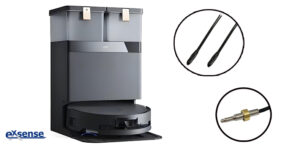The Key to Robotic Cleaner Temperature Control: NTC Temperature Sensors
 Driven by rapid advancements in artificial intelligence and robotics, robotic vacuum cleaners are becoming ubiquitous in modern households as essential home automation devices. Beyond basic automated cleaning, they integrate advanced functions like smart self-charging, navigation-based cleaning, mop self-cleaning, and hot-air drying. Their efficient and stable operation relies on the precise coordination between energy storage battery systems and cleaning bases, where NTC Temperature sensors serve as critical sensing components, providing indispensable technical support. Below is a systematic analysis of their functional mechanisms:
Driven by rapid advancements in artificial intelligence and robotics, robotic vacuum cleaners are becoming ubiquitous in modern households as essential home automation devices. Beyond basic automated cleaning, they integrate advanced functions like smart self-charging, navigation-based cleaning, mop self-cleaning, and hot-air drying. Their efficient and stable operation relies on the precise coordination between energy storage battery systems and cleaning bases, where NTC Temperature sensors serve as critical sensing components, providing indispensable technical support. Below is a systematic analysis of their functional mechanisms:
Ⅰ.Detailed Analysis of NTC Temperature Sensors in Robotic Cleaner
- NTC Temperature Sensors for Robotic Cleaner Batteries
The energy storage battery inside a robotic vacuum stores electricity via its base station, enabling extended autonomous cleaning. However, during continuous operation, battery packs generate significant heat. Research shows these batteries’ optimal operating temperature range is 20–25°C. Prolonged exposure outside this range drastically reduces battery lifespan and compromises device performance.
NTC temperature sensors continuously monitor battery temperature, establishing an intelligent protective barrier. Upon detecting temperatures exceeding safety thresholds, the control system responds instantly by reducing charging power and energy output, effectively preventing overheating and ensuring safe, stable battery operation.
▉Selection Recommendation: Epoxy-head NTC temperature sensors are ideal for monitoring battery packs. They can be easily adhered to battery surfaces with silicone, and their head size supports customization to fit various battery specifications, ensuring precise temperature tracking.
- NTC Temperature Sensors for Water Temperature in Robotic Cleaner
The mop-cleaning function relies on the base station’s washing tank, where maintaining optimal water temperature is crucial for effective cleaning. Experimental data indicate 75°C as the ideal cleaning temperature, and water must exceed 55°C to eliminate E. coli on mops effectively.
NTC temperature sensors continuously monitor water temperature in the tank. Through intelligent regulation, they maintain stable water temperatures, enhancing cleaning efficiency while suppressing bacterial growth at its source.
▉Selection Recommendation: For monitoring water temperature in cleaning bases, insertion-type metal-shell NTC temperature sensors excel. They feature compact dimensions and easy installation and are available in SUS304, SUS316, nickel-plated copper, and other materials. With rapid response times (as fast as 0.3s) and an operational range of -40°C to 150°C, they are widely suitable for robotic vacuums, coffee machines, smart toilets, smart showers, water heaters, dispensers, and other consumer electronics requiring precise liquid temperature measurement, offering exceptional versatility and practicality.
Ⅱ.Key Considerations for Sensor Selection
Selecting the right NTC temperature sensor for Robotic Cleaner demands a comprehensive evaluation of multiple factors:
Product compatibility (structural fit, material weather resistance, dimensional adaptability)
Core performance parameters (temperature range, accuracy, response time)
Application environment (temperature fluctuations, humidity, dust levels)
Supplier capabilities (technical support, supply chain stability)
Ⅲ.Partnering with EXSENSE
EXSENSE fully supports your needs for material optimization, model compatibility, and technical collaboration. For technical inquiries or customized solutions, contact our expert team anytime!
It is worth noting: Both sensor types mentioned above are certified to international standards (e.g., ISO, CE), offering superior reliability, consistency, and environmental adaptability, ensuring long-term stable operation for your robotic vacuums.













